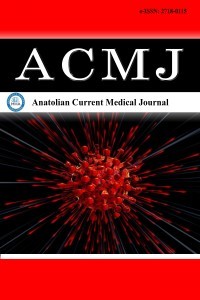
Anatolian Current Medical Journal
Yazarlar: ["Pervin BALCI"]
Konular:-
DOI:10.38053/acmj.1166370
Anahtar Kelimeler:Penicillin,Erythromycin,Streptococcus pyogenes,Tonsillitis,Pharyngitis,Laryngitis
Özet: Aim: Streptococcus pyogenes (Group A Beta-hemolytic streptococci, GABHS) is one of the important bacterial pathogens in clinical microbiology. It often causes upper respiratory tract infections such as tonsillitis, pharyngitis, and laryngitis. It also leads to complications such as acute rheumatic fever and post-streptococcal glomerulonephritis. Early diagnosis and treatment of these bacterial infections will prevent suppurative and non-suppurative complications, the transmission of infection to other people, and chronic carriage. Today, the treatment of streptococcal infections relies entirely on chemotherapy. Beta hemolytic group A streptococci and generally other beta-hemolytic streptococci in groups B (GBBHS), C, and G are generally sensitive to many chemotherapeutics, especially Penicillin and Erythromycin. In patients with penicillin allergy, erythromycin, amoxicillin-clavulanate, or oral cephalosporins are used instead of penicillin. However, it has recently been understood that there are strains resistant to Erythromycin in GABHS and are increasing. In this study, the situation in our region of Erythromycin resistance, which is used as an alternative for people allergic to Penicillin in the treatment of streptococcal infections, was investigated. Material and Method: In our study, throat swab samples were taken from 150 pharyngitis patients and 94 GABHS were obtained by applying the Bacitracin-SXT test with the culture method, and antibiotic susceptibility tests were performed on these 94 GABHS by Kirby-Bauer agar disc diffusion method. Result: GABHS was found susceptible to Bacitracin and resistant to SXT. GBBHS is resistant to Bacitracin and SXT. other beta-hemolytic streptococci were resistant to Bacitracin and susceptible to SXT. Conclusion: In this study, Erythromycin’s resistance was found to be 19.1%. it is observed that Erythromycin resistance has increased over the years when compared to previous studies. Erythromycin should not be used empirically in treatment. An antibiotic susceptibility test should be performed and the antibiotic should be selected according to the results of the antibiogram test.